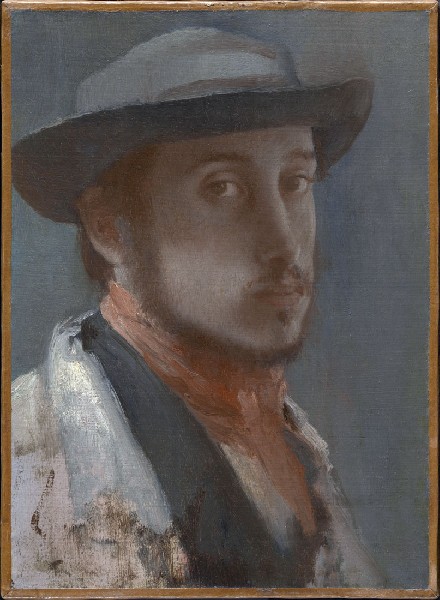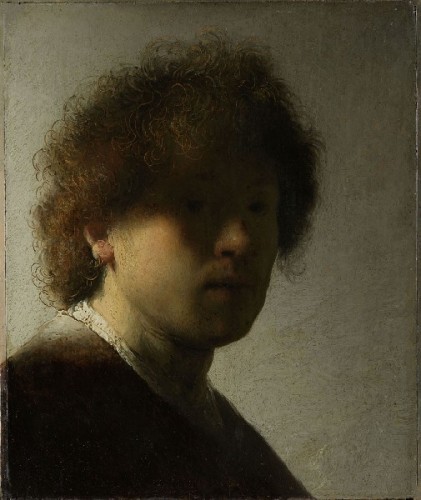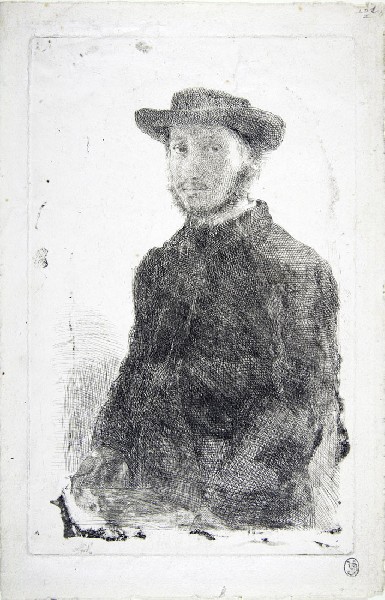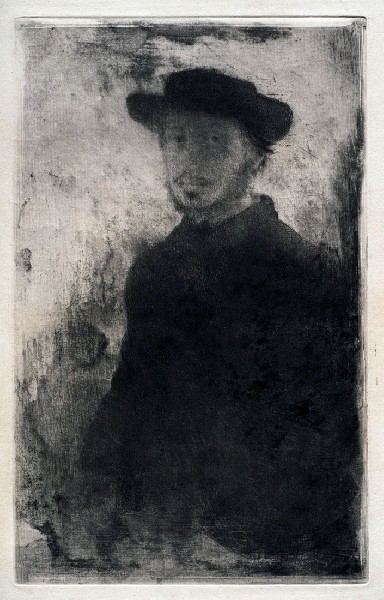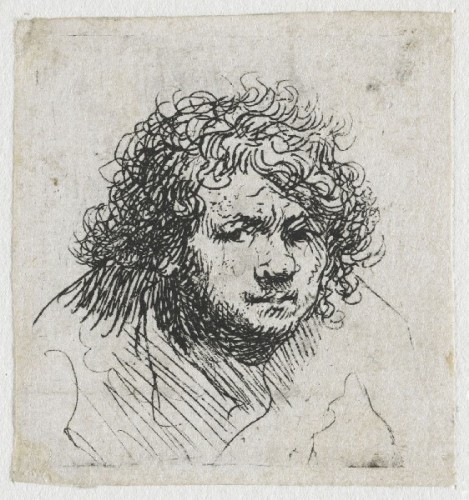Rembrandt and Degas: Two Young Artists
Clark Art Institute to February 5
By: Charles Giuliano - Nov 13, 2011
Rembrandt and Degas: Two Young Artists
Clark Art Institute
525 South Street
Williamstown, Mass.
Hours: Tuesdays – Saturdays, 10 a.m. to 5 p.m.
To February 5
After That, Metropolitan Museum of Art
The word juvenilia is used to describe the work of a young artist. It generally means the developmental process which entails exploring techniques and media as well efforts to establish an original approach and style.
This is one way to process a miniscule but evocative exhibition, confined to a single gallery in a warren of them, now empty and undergoing renovation at the Clark Art Institute in Williamstown, Mass.
Those who tore themselves away from a typically sumptuous spread during the opening this weekend emitted gasps of surprise at the tiny presentation. The prevailing impact was one of shock and disappointment.
The area devoted to the small project did not even fill the entire space with works by the renowned and bankable artists Rembrandt and Degas. There was a kind of antechamber or prequel of 19th century copies after Rembrandt’s etchings. This led into a second modest space which contained two small painted self portraits each by both artists as well as a number of self portrait etchings.
During our visit, observing the behavior and dialogue of visitors, the entire experience took a few frenetic minutes then back to the buffet. Or, for more knowledgeable individuals, a lifetime of observation and contemplation.
Despite its unimposing scale this is a richly satisfying almost overwhelming encounter with “Rembrandt and Degas: Two Young Artists.” Initially it might appear to be more of a PR and marketing coup than a project based on solid art historical intentionality.
On a PR level the exhibition serves a mandate for the museum to remain at least partially open through construction and renovation until the summer of 2014. Under such circumstances most museums simply shut down. Overhearing remarks from the scattering of individuals who took the trouble to see the exhibition many did not appear to know that the permanent collection galleries are now closed.
There were remarks on the order of “Oh yes I remember reading something about this in the Eagle.”
As to the scholarly legitimacy of connecting the Dutch baroque artist Rembrandt van Rijn (1606-1669) and the French impressionist, Edgar Degas (1834-1917), the premise rests on a slight but direct link. Degas was 31, in 1856, when he traveled to Italy to study Renaissance art. He would remain for the next 33 months. While in Rome he would copy a Rembrandt self portrait etching. Both works are on view in the current exhibition.
For a curator it is the kind of eureka “Houston we have contact” discovery that sets in motion a star studded, glitzy project such as this. It is a billing that will surely lure visitors to the Clark between now and February 5 after which the show heads to the Metropolitan Museum of Art. There it will serve as a sidebar to everything else going on at that great institution. But, here at Williamstown, during the dark months and down time the pairing is a really big deal.
The Clark’s Degas “Self Portrait” has always been among my absolute favorites in that great collection with such strength in 19th century French Painting. It is the trump card around which ambitious curators are able to build projects. In this instance it is the magnet which has attracted those scrumptious and stunning, heart thumping little self portraits by Rembrandt. The precious context of this jewel box setting allows us to entirely focus on their magnificence without any distractions. The other Degas painting on loan from the Met is substantial but not on the level of these three works.
Rembrandt was just a pup of 22 when he painted the self portrait loaned by the Rijksmuseum in Amsterdam. The other equally terrific painting has been loaned by the Alte Pinakothek in Munich.
While the curators present iron clad evidence of the interest of Degas in the etching of Rembrandt their sensibilities, enforced by a careful study of the works on view, could not be more diverse. The young Rembrandt, rooted in the genre painting of the time, with its penchant for comical, low life characters and tavern scenes, mugs and grimaces in the mirror looking for nuances of quirky personality. By contrast, Degas was cool and reserved. He remains an enigma for art historians looking to extract clues to his feelings through the works he created.
It is precisely that cold, detached arrogance and hauteur that has always proved to be so riveting about the Clark picture. No artist has ever depicted himself with such clinical detachment bordering on contempt and disdain for the viewer. With its intensity and mastery of the craft, it invites one to love the work while feeling misgivings about its creator. Words such a misanthrope and misogynist have been used in endless scholarly arguments attempting to come to terms with a truly great artist who was one cool dude.
What is so riveting about this work, glib and magnificent in its command of the craft, is the seed of that complex and enigmatic persona. With his head slightly tilted, his eyes are shaded by a hat. That use of diminished chroma evokes a sense of introspoective mood. The rendering of his features is accomplished with thin, smooth, pale nuances of paint. This thin paint is contrasted by bravura passages of impasto applied with gusto around the collar and shirt. The lower edge of the work is unfinished conveying the sense of a hasty sketch despite the fact that the features are exsquitely finished. There is the impact of packing a lot of varied visual information into a confined area.
Compared to the cool restraint of the Clark's Degas, Rembrandt, even here at the inception of his career, was a gush of emotion. The young Rembrandt was bold, experimental, and wildly successful. He was happily, no ecstatically, married to an heiress, Saskia. Her family shuddered that she married down to an artist. But he was in demand as a portrait painter and consequently rich. That all came to an abrupt end about the time of that great failure popularly know as The Night Watch. It is also when Saskia died in 1642 not long after the birth of their son Titus. Then 36, he went into bankruptcy, and the auction of his household possessions to settle debts remains a primary document for scholars.
The ever darker and more horrific self portraits, ignored by collectors of his time, charted the rise and fall of one of our greatest artists.
The two early paintings on view at the Clark convey sanguine youth and an artist peering deeply in the mirror attempting to plunge into the depth of limited life experience. He was also feeling the indirect influence of Caravaggio through its Dutch ambassadors the Utrecth Candlelight painters and their pursuit of dramatic chiaroscuro and sharp focus realism. It was Caravaggio, a genius and criminal, who pulled art out of the artifice of mannerism and the harsh realities and horrors of the Counter Reformation. Rembrandt never traveled, and there is no evidence that he saw a work by Caravaggio. But his influence pervaded Europe and defined the baroque style which Rembrandt pursued.
This is evident in the two early Rembrandt self portraits in this exhibition. His character peers out at us through a pervasive low light and deep shadow that subsumes the features other than the intense gaze of all but obscured eyes. Such brooding darkness is the opposite of what one might expect from sanguine youth. The surface is smooth and glazed over. With a small brush he depicts many individual, unruly strands of hair. Rembrandt is less intent on capturing his features, a conventional portrait, than establishing his character and persona.
It is important to point out that just two paintings is too small a sample to make broad assumptions about the early self portraits which are actually quite varied. It is more likely that the curators selected these two works the better to make a match with the Clark's melancholy Degas. Accordingly, it skews the evidence to enforce a slim scholarly thesis. It will be quite convincing to the casual observer.
The young Rembrandt felt these seismic social, political and religious after shocks in much diminished intensity. He absorbed it as a style to assume. In his mid 30s, he made a disastrous career move. As he found fewer lucrative portrait commissions, after the debacle of the Night Watch, he delved ever deeper into religious art. Clearly it was a wrong decision in a protestant country noted for Lutheran and Calvanist inspired iconoclasm. The Dutch were intent on removing religious art from their churches. There were no patrons for the works which were ignored at the time and so treasured today.
The real link between Degas and the earlier Rembrandt is more connected to the medium of etching than the style, emotion and content of the work. Degas was on the right track as the etchings in this show reveal. From Rembrandt he acquired the approach of treating plates with multiple workings or states.
Etching is more fresh and spontaneous than the engravings of the Renaissance master Durer. It takes patience, skill and consummate control to make engravings and woodcuts. With etching the artist covers a copper or zinc plate with resin. This is then scratched with a needle to expose the metal which is burned in acid. The plate may also be scratched and worked directly with drypoint. Effects of shadow may be created with aquatint in which areas are blocked or resisted as well as burned. Rembrandt would also edit plates by scratching away or burnishing areas.
It was this rich vocabulary of approaches in the prints of Rembrandt that served as a lure for the early work of Degas.
There is too small a sample of work on view in the Clark exhibition to deeply explore the full range and impact of the influences. The limit is to focus on the self portraits. We know that Degas continued to experiment with print media and pastel. Always there was a grounding in aspects of drawing which is again a connection between these masters.
Degas also had to absorb and grow beyond the neoclassicism of David and Ingres. Mostly we regard the paradigm of impressionism through landscape. For Degas, however, the fixation was on figuration and drawing. There was an expansion from the studio nudes of neoclassicsm to the liberation of Romanticism through Delacroix. Then beyond that into the movement and action of dancers, bathers, horses and their jockeys.
That is of course another story and we have digressed far from the matrix of a tiny, exquisite Clark show from which swirls an unchecked cosmos of other possibilities.
Plan to see this show for more than a few minutes.

